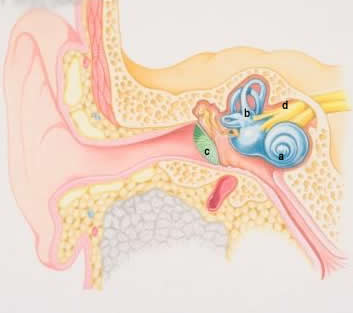
On the site introduction what is it? main symptoms more symptoms diagnosis treatment self help my story my diary driving A-Z disability hereditary burn out salt Prosper Meniere famous people staying positive stress feedback search |
A basic descriptionOn the internet you will find varying explanations of what Meniere's disease is. It is sometimes called Meniere's syndrome. In its most simple explanation, Meniere's disease is a disorder of the inner ear where the organs of balance and hearing exist. In Meniere's the balance mechanism is faulty and sends incorrect messages to the brain causing vertigo and dizziness. As the balance mechanism malfunctions, the hearing organs are damaged causing the tinnitus and hearing loss.You have separate organs for each ear, however usually only one ear is affected (unilateral), though some develop it in both ears which is called Bilateral Meniere's. If you would like a better understanding, please read on. A more medical description is necessary, but I have tried to explain in plain English. Further detail (with some medical terms)A healthy balance organ (see illustration b :semi circular canals) contain endolymph, an inner ear fluid that works with hair cells and crystals to send position and movement signals to the brain. Your eyes and various sensors in the body will also be providing information to the brain, and when all of this information matches, all is well. The most popular theory for Meniere's symptoms occurring, is when, for unknown reasons, the endolymph, hair cells and crystals start to work incorrectly. Within the inner ear is the endolymphatic sac which seems to act like an overflow or sponge for any excess endolymph. (This sac is not seen in the illustration below as it located just behind the semi circular canals) . Continued underneath illustration.
A blockage in the neck of the endolymphatic sac leaves nowhere for excess endolymph fluid to drain, or a more recent theory is that the sac fills to capacity, then a backwash of endolymph occurs. Either way, the result of this would be an increase in pressure and swelling or even a temporary rupture causing the fluid to leak out. To the individual, the pressure and/or leak will result in incorrect balance signals being sent to the brain. The conflict of signals/information results in vertigo. In medical terms this occurrence is known as endolymphatic hydrops (hydrops means swelling). As this happens again and again, other parts of the inner ear are damaged hence tinnitus and loss of hearing, worsening with every occurrence. There are other variations on this theory, and completely alternative opinions to this. This web site has been written and developed by Alex Tye - "MrLexy" on the internet! |
||||
